Range of applications
Settling basins are used as a separation mechanism to eliminate rejected products (i.e. waste solids management strategies) of a specified size and quantity in various fields, such as aquaculture, mining, dairy, food processing, alcohol production and wine making. Regular draining and desilting of settling basins is required to maintain satisfactory performance. [7]
Aquaculture
All materials not removed from the system during harvesting are categorized as wastes including uneaten feed, excreta, chemicals and therapeutics, dead and moribund fish, escaped fish and pathogens. Settling basins in the field are simple ponds dug downstream of the farm to optimally remove suspended solids effectively, produce clarified effluent, and accumulate and thicken sludge to minimal volume. If impairment occurs in any of these functions, this might have a great impact on pond performance, which could lead to damaging the effectiveness of the process. [8]
Mining
Wastewater produced by mining industries contribute to the acidity, suspended material and dissolved heavy metal ions in the aquatic environment, causing environmental problems for biological life and discoloration of the receiving waters. The application of settling basins by the Coeur d’Alene mining district of northern Idaho, United States, globally known to produce lead, zinc and silver, to treat wastewater has greatly improved the quality of water discharge from mining operations. [9]
Dairy waste
By reducing flow velocity to limit solids being transported along with fast flowing liquid, separation can occur. Approximately 35% – 60% of the solids is removed from dilute liquid slurry, with 10 minutes detention time, with a common detention time of 30 to 60 minutes. Due to the inadequate consideration of critical design criteria, most settling basins built were oversized and had low efficiency. [10]
Settling basins used in dairy production reduce the nutrient-loading on a vegetative filter strip from lot runoff, thus decreasing the required lagoon volume for a new facility. Moreover, settling basins are useful to remove unwanted solid materials, such as hay, straw and feathers from the waste stream before flowing to the lagoon, aids to reduce smell and avoid crust formation on the lagoon surface. A baffle may be used to retain the floating solids removed. There are two types of settling basins, based on the method of removing solids. With one type, the solids are removed mechanically (after the free water has drained away), usually with a front-end or skid-steer loader. The other type uses hydraulic (pump) removal of the solids. Typically, pumping is initiated when the basin is half full of solids and the remainder is water. Vigorous agitation is needed to mix the liquid and the solids, preferably by propeller-type agitators or pumps with agitation nozzles. [11]
Advantages and limitations over competitive processes
Settling basins are designed to retain water long enough so that suspended solids can settle to obtain a high purity water in the outlet and to provide the opportunity for pH adjustment. [12] Other processes that could be used: thickeners, clarifiers, hydro cyclones and membrane filtration are highly used techniques in the field. [13] Compared to those processes, settling basins have a simpler and cheaper design, with fewer moving parts, demanding less maintenance, despite requiring cleaning and vacuuming of the quiescent zones at least once every two weeks.
However, settling basins can introduce new kinds of water contamination, particularly if the water supply is from a well. The basin can catch windblown contaminants, and if the water is retained for a long period, algae grows in the pool, leading to greater filtration problems. Settling ponds may also be ineffective at reducing turbidity caused by small particles with specific gravity low enough to be suspended by Brownian motion. Usually, it can only remove particles ranging from sand (2 mm in diameter) to silt (0.002 mm in diameter).

Water treatment is any process that improves the quality of water to make it appropriate for a specific end-use. The end use may be drinking, industrial water supply, irrigation, river flow maintenance, water recreation or many other uses, including being safely returned to the environment. Water treatment removes contaminants and undesirable components, or reduces their concentration so that the water becomes fit for its desired end-use. This treatment is crucial to human health and allows humans to benefit from both drinking and irrigation use.
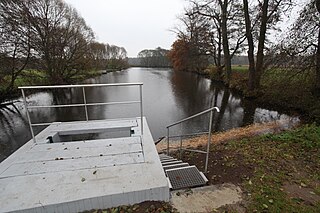
Settling is the process by which particulates settle to the bottom of a liquid and form a sediment. Particles that experience a force, either due to gravity or due to centrifugal motion will tend to move in a uniform manner in the direction exerted by that force. For gravity settling, this means that the particles will tend to fall to the bottom of the vessel, forming a slurry at the vessel base.
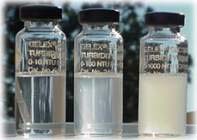
Turbidity is the cloudiness or haziness of a fluid caused by large numbers of individual particles that are generally invisible to the naked eye, similar to smoke in air. The measurement of turbidity is a key test of water quality.

Wastewater treatment is a process used to remove contaminants from wastewater and convert it into an effluent that can be returned to the water cycle. Once returned to the water cycle, the effluent creates an acceptable impact on the environment or is reused for various purposes. The treatment process takes place in a wastewater treatment plant. There are several kinds of wastewater which are treated at the appropriate type of wastewater treatment plant. For domestic wastewater, the treatment plant is called a sewage treatment plant. For industrial wastewater, treatment either takes place in a separate industrial wastewater treatment plant, or in a sewage treatment plant. Further types of wastewater treatment plants include agricultural wastewater treatment plants and leachate treatment plants.
Total suspended solids (TSS) is the dry-weight of suspended particles, that are not dissolved, in a sample of water that can be trapped by a filter that is analyzed using a filtration apparatus. It is a water quality parameter used to assess the quality of a specimen of any type of water or water body, ocean water for example, or wastewater after treatment in a wastewater treatment plant. It is listed as a conventional pollutant in the U.S. Clean Water Act. Total dissolved solids is another parameter acquired through a separate analysis which is also used to determine water quality based on the total substances that are fully dissolved within the water, rather than undissolved suspended particles.

A constructed wetland (CW) is an artificial wetland to treat municipal or industrial wastewater, greywater or stormwater runoff. It may also be designed for land reclamation after mining, or as a mitigation step for natural areas lost to land development. Constructed wetlands are engineered systems that use natural functions vegetation, soil, and organisms to treat wastewater. Depending on the type of wastewater the design of the constructed wetland has to be adjusted accordingly. Constructed wetlands have been used to treat both centralized and on-site wastewater. Primary treatment is recommended when there is a large amount of suspended solids or soluble organic matter.

Waste stabilization ponds are ponds designed and built for wastewater treatment to reduce the organic content and remove pathogens from wastewater. They are man-made depressions confined by earthen structures. Wastewater or "influent" enters on one side of the waste stabilization pond and exits on the other side as "effluent", after spending several days in the pond, during which treatment processes take place.

Industrial wastewater treatment describes the processes used for treating wastewater that is produced by industries as an undesirable by-product. After treatment, the treated industrial wastewater may be reused or released to a sanitary sewer or to a surface water in the environment. Most industrial processes, such as petroleum refineries, chemical and petrochemical plants have onsite facilities to treat their wastewaters so that the pollutant concentrations in the treated wastewater comply with the regulations regarding disposal of wastewaters into sewers or into rivers, lakes or oceans. Industrial wastewater treatment plants are required where municipal sewage treatment plants are unavailable, do not have sufficient capacity or cannot adequately treat specific industrial wastewaters.
Electrocoagulation (EC) is a technique used for wastewater treatment, wash water treatment, industrially processed water, and medical treatment. Electrocoagulation has become a rapidly growing area of wastewater treatment due to its ability to remove contaminants that are generally more difficult to remove by filtration or chemical treatment systems, such as emulsified oil, total petroleum hydrocarbons, refractory organics, suspended solids, and heavy metals. There are many brands of electrocoagulation devices available and they can range in complexity from a simple anode and cathode to much more complex devices with control over electrode potentials, passivation, anode consumption, cell REDOX potentials as well as the introduction of ultrasonic sound, ultraviolet light and a range of gases and reactants to achieve so-called Advanced Oxidation Processes for refractory or recalcitrant organic substances.
Dissolved air flotation (DAF) is a water treatment process that clarifies wastewaters by the removal of suspended matter such as oil or solids. The removal is achieved by dissolving air in the water or wastewater under pressure and then releasing the air at atmospheric pressure in a flotation tank basin. The released air forms tiny bubbles which adhere to the suspended matter causing the suspended matter to float to the surface of the water where it may then be removed by a skimming device.
Sedimentation is a physical water treatment process using gravity to remove suspended solids from water. Solid particles entrained by the turbulence of moving water may be removed naturally by sedimentation in the still water of lakes and oceans. Settling basins are ponds constructed for the purpose of removing entrained solids by sedimentation. Clarifiers are tanks built with mechanical means for continuous removal of solids being deposited by sedimentation. Clarification does not remove dissolved species. Sedimentation is the act of depositing sediment.

Secondary treatment is a treatment process for wastewater to achieve a certain degree of effluent quality by using a sewage treatment plant with physical phase separation to remove settleable solids and a biological process to remove dissolved and suspended organic compounds. After this kind of treatment, the wastewater may be called as secondary-treated wastewater. Secondary treatment is the portion of a sewage treatment sequence removing dissolved and colloidal compounds measured as biochemical oxygen demand (BOD). Secondary treatment is traditionally applied to the liquid portion of sewage after primary treatment has removed settleable solids and floating material. Secondary treatment is usually performed by microorganisms in a managed aerobic habitat. Bacteria and protozoa consume biodegradable soluble organic contaminants while reproducing to form cells of biological solids. Secondary treatment by biochemical oxidation of dissolved and colloidal organic compounds is widely used in sewage treatment and is applicable to some agricultural and industrial wastewaters.
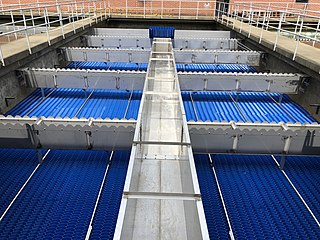
A lamella clarifier or inclined plate settler (IPS) is a type of settler designed to remove Particulates from liquids.

An API oil–water separator is a device designed to separate gross amounts of oil and suspended solids from industrial wastewater produced at oil refineries, petrochemical plants, chemical plants, natural gas processing plants and other industrial oily water sources. The name is derived from the fact that such separators are designed according to standards published by the American Petroleum Institute (API).

Most organisms involved in water purification originate from the waste, wastewater or water stream itself or arrive as resting spore of some form from the atmosphere. In a very few cases, mostly associated with constructed wetlands, specific organisms are planted to maximise the efficiency of the process.

Clarifiers are settling tanks built with mechanical means for continuous removal of solids being deposited by sedimentation. A clarifier is generally used to remove solid particulates or suspended solids from liquid for clarification and/or thickening. Concentrated impurities, discharged from the bottom of the tank are known as sludge, while the particles that float to the surface of the liquid are called scum.
Depth filters are the variety of filters that use a porous filtration medium to retain particles throughout the medium, rather than just on the surface of the medium. These filters are commonly used when the fluid to be filtered contains a high load of particles because, relative to other types of filters, they can retain a large mass of particles before becoming clogged.

A sediment control is a practice or device designed to keep eroded soil on a construction site, so that it does not wash off and cause water pollution to a nearby stream, river, lake, or sea. Sediment controls are usually employed together with erosion controls, which are designed to prevent or minimize erosion and thus reduce the need for sediment controls. Sediment controls are generally designed to be temporary measures, however, some can be used for storm water management purposes.
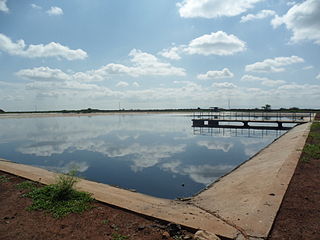
Facultative lagoons are a type of waste stabilization pond used for biological treatment of industrial and domestic wastewater. Sewage or organic waste from food or fiber processing may be catabolized in a system of constructed ponds where adequate space is available to provide an average waste retention time exceeding a month. A series of ponds prevents mixing of untreated waste with treated wastewater and allows better control of waste residence time for uniform treatment efficiency.
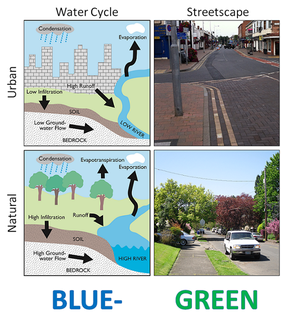
Water-sensitive urban design (WSUD) is a land planning and engineering design approach which integrates the urban water cycle, including stormwater, groundwater and wastewater management and water supply, into urban design to minimise environmental degradation and improve aesthetic and recreational appeal. WSUD is a term used in the Middle East and Australia and is similar to low-impact development (LID), a term used in the United States; and Sustainable Drainage System (SuDS), a term used in the United Kingdom.
















